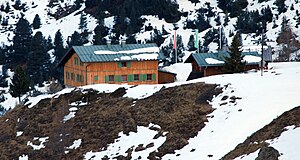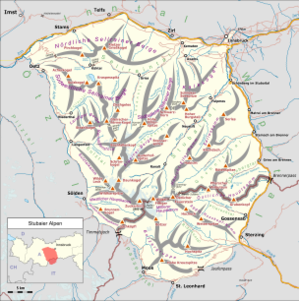Schweinfurter Hut
| Schweinfurter Hütte DAV hut category I |
||
|---|---|---|
|
Schweinfurter Hut from the south |
||
| location | Großhorlachalm; Tyrol , Austria ; Valley location: Niederthai near Umhausen | |
| Mountain range | Stubai Alps | |
| Geographical location: | 47 ° 9 '28 " N , 11 ° 1' 11" E | |
| Altitude | 2028 m above sea level A. | |
|
|
||
| owner | Section Schweinfurt of the DAV | |
| Built | 1912 | |
| Construction type | hut | |
| Usual opening times | Mid-February to early May; Mid June to early October | |
| accommodation | 18 beds, 38 camps , 8 emergency camps | |
| Winter room | 8 bearings | |
| Web link | Website at the section | |
| Hut directory | ÖAV DAV | |
The Schweinfurter Hütte (founded as Hersfelder Hütte , later Gubener Hütte and until 2008 Guben-Schweinfurter Hütte ) is an Alpine Club hut of the Schweinfurt section of the German Alpine Club at 2028 m above sea level. A. Height at the beginning of the Zwieselbach valley (extension of the Horlach valley ) in the Stubai Alps near Niederthai in the municipality of Umhausen . The hut is located in the quiet area of the Stubai Alps.
history
The origins of today's Alpenvereinshutte go on a 1,912 by shooting tenant Commerce Fritz Rechenberg from Hersfeld built cabin back; therefore initially called Hersfelder Hütte . He chose a rubbish cone below the Zwieselbacher Rosskogel ( 3,082 m ) as a stand for the stone house in the style of an alpine farm .
This was preceded by an agreement - between the Guben section of the German and Austrian Alpine Club (DuOeAV), founded on December 12, 1894, and the Frankfurt an der Oder section, founded in 1885 - to lay out and mark a path from Kühtai over the Finstertal lakes , the Finstertaler Scharte to Zwieselbachalm and over Zwieselbachjoch to the Winnebachseehütte built in 1900/01 . The "Gubener Weg" was created, which soon after became a much-used passage to Niederthai . This made this region the work area of the Guben section.
An agreement was reached between the builder and the section that a room for mountaineers should be set up. Already one year later there were first negotiations about the acquisition of the hut by City Councilor Richard Schlief. In 1918 Georg and Alois Leiter, Niederthai, both members of the section since 1914, bought the hut with funds from City Councilor Schlief. Hansjörg Leiter, Hittls, was a game warden.
The hut was inaugurated on July 25, 1922 as the Gubener hut . In 1923 Alois Leiter and the Guben Section signed a purchase contract. The entry of the section as owner in the land register took place on February 17, 1925. In 1930, the section converted and extended it into a simple mountain hut . This was preceded by a purchase of land by Ludwig Falkner, Jenneweins, and Andrä Grießer, Anderle, in the same year. The inauguration of the extended hut takes place on July 5, 1931. The hut was first used in winter in 1932. In that year, the Gubener hut counted around 400–600 guests, in summer 600, with 180 overnight stays. In 1938/39 the Guben section planned a new building, but this did not come about due to the outbreak of war.
During the final months of the Second World War in 1945, the interior furnishings were devastated by dispersed troops. Like all German huts in Austria, the Gubener Hütte was confiscated by the Allies as enemy property after the end of the war, expropriated and later transferred to the Austrian Alpine Association (OeAV), newly founded in 1945, for administration. However, the latter only regarded himself as a trustee and waited with the German Alpine Association (DAV) for the day when the German huts could be returned to German sections. In 1955, the Austrian State Treaty passed the German smelters into the possession of the Republic of Austria , which later sold them to the OeAV for 600,000 schillings. The change of ownership had no practical effect on the huts.
However, since most of Guben is east of the Oder , this part fell into Polish administrative territory as a result of the Potsdam Agreement . The remainder of Brandenburg fell into the Soviet Occupation Zone (SBZ), and from October 7, 1949 into the German Democratic Republic (GDR). Because of the prohibition of the DAV issued by the SBZ and the state territory of the GDR that was cordoned off for emigration from May 1952, the members of the Guben section were no longer able to take care of the mountain hut. In 1956, the Presidium of the German Alpine Club established the connection to the Lower Franconian section of Schweinfurt. From November 1st to 4th, 1956, a meeting of the board members of both sections took place at the hut to establish initial contact about cooperation. This led to the conclusion of a sponsorship agreement between the two sections in 1957. The Schweinfurt section took on more or less responsibility for the management of the mountain hut. The commitment was expressed in the future new name of the hut, which was stipulated in the sponsorship contract: from now on it was referred to as the Guben-Schweinfurter hut .
The mountain hut was expanded in 1963/64 to the size it is today with 56 beds in rooms and dormitories. The Schweinfurt section was in charge of the implementation, as the Guben section lacked the funds at the time. In 1969 the DAV bought all of its huts back from the OeAV for 600,000 schillings. In 1973 the DAV separated from the smelter property and sold the property together with the property to the Schweinfurt section. From then on she was responsible for its operation and maintenance. In April 1974 a smoldering fire triggered by an overheated stove destroyed the upper and attic storeys: when a wooden paneling was opened and the smoke came out, the smoldering fire ignited. With the snow lying at the end of April, the fire could not be extinguished, and by the time the landlord's daughter ran barefoot into the valley to call the fire brigade, the two upper floors were completely burned out. The reconstruction took place in the same year. The completion was at the end of September 1974. It went on cautiously. In 1980/1981 a winter house with 16 beds was built.
A new water supply followed in 1983, electrification and the telephone in 1986. The section was happy to pay the costs for connecting the hut to the transformer station 1000 meters away on Almenweg from Klein-Horlachalm, because electricity made life in the hut immensely easier. In 1990 there was a new spring intake for the drinking water supply. In 1996/97 a storage room for kitchen supplies was built and in 1998 a small waste water disposal system (KABA) with four chambers and grease separators was completed. In 2001 they were officially approved. Since then it has been emptied once a year. You may not drive up to the hut, but there is still a driveway for such purposes.
Between 2004 and 2006, the hut was completely renovated in accordance with the contemporary requirements and requirements of the authorities and equipped with a new pellet heating system with hot water preparation for drinking and industrial water, and the previous 13 individual stoves were removed from all floors, which increased fire protection. In addition, the sanitary rooms, thermal insulation and new insulating glass windows were modernized. In addition, there was the redesign of the guest rooms and the kitchen. In 2007 the hut received the environmental seal of approval for Alpine Club huts .
Until July 2008 the hut was called Guben-Schweinfurter Hütte for traditional reasons . At the instigation of the Schweinfurt section, the name was then changed to Schweinfurter Hütte, with the proposed addition “formerly Gubener Hütte”.
In 2010 the renowned alpine and outdoor mountaineering magazines awarded the hut the coveted title of “Hut of the Month”.
The Schweinfurter Hütte is a Category I refuge with 70 beds. Five dormitories for two to five people and three dormitories for eight, nine and 19 people are available in the main building. There are another 16 storage spaces in the winter house. The two dining rooms are also suitable for groups and as seminar rooms.
getting there
- by train: from Innsbruck towards Arlberg to Ötztal -Bahnhof. From there by post bus to Umhausen
- By car: from Innsbruck on the A12 motorway towards Arlberg to the Ötztal exit. Then on federal highway 186 to Umhausen and from there to the parking lot after the bridge in Niederthai; or from the north via Munich - Garmisch-Partenkirchen - Fernpass - Ötz.
Accesses
- from Niederthai ( 1535 m ), walking time: 2 hours
Transitions
- Neue Bielefelder Hütte ( 2112 m ) over the Hochreichscharte ( 2912 m ), walking time: 8–9 hours
- Dortmunder Hütte ( 1949 m ) over the Finstertaler Scharte ( 2779 m ), walking time: 5 hours
- Pforzheimer Hütte ( 2308 m ) over the Gleirschjöchl ( 2750 m ), walking time: 3–4 hours
- Winnebachseehütte ( 2361 m ) over the Zwieselbachjoch ( 2870 m ), walking time: 5 hours
Mountaineering
- Jubilee cross on the Paistakogel ( 2643 m ), walking time: 2½ hours
- Gruejoch ( 2710 m ), walking time: 2½ hours
- High waterfall ( 3003 m ), walking time: 3½ hours
- Kraspesspitze ( 2954 m ), walking time: 2½ hours
- Zwieselbacher Rosskogel ( 3082 m ), walking time: 3 hours
- Gleirscher Rosskogel ( 2994 m ), walking time: 2¾ hours
- Hochreichkopf (3010 m); Walking time 3–3½ hours
Web links
Individual evidence
- ↑ a b c Position and altitude according to AustrianMap
- ↑ Archived copy ( Memento of the original from March 4, 2016 in the Internet Archive ) Info: The archive link was inserted automatically and has not yet been checked. Please check the original and archive link according to the instructions and then remove this notice.

